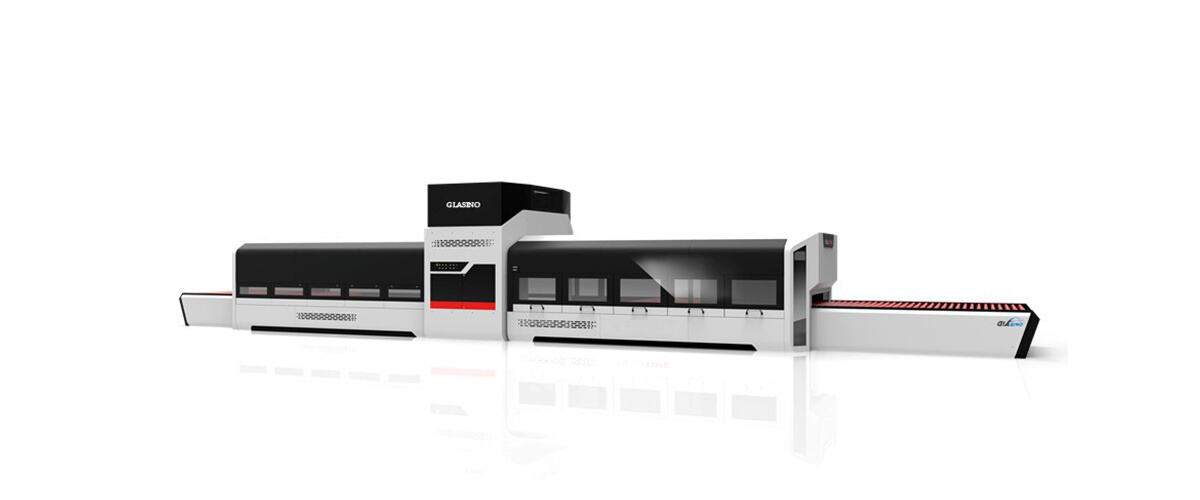
1.Technical Specifications:
1.1.Basic parameters
1.2.Installation Power&Transformer Capacity
1.3.Other requirements(Supplied by buyer)
2.Brief Introduction of Main Sections
2.1.Loading table
2.1.1.Size:pls see the attached layout
2.1.2.Roller diameter and quantity:as final designed
2.1.3.Roller distance:120mm
2.1.4.Positioning device to guarantee the right position according to glass shape
2.1.2.Material of roller:there are two kinds of roller,one is the rubber coated roller;one is the steel roller with kevlar rope which near to the oven door.
2.1.6.The first roller is free of operation,which is easy for loading the glass
2.1.7.Side rubber-coated rollers are used for loading the glass of large size
2.1.8.Equipped with elevating table with castors,using cylinder up and down mechanical system to lift and lower down the four angles of the loading table at the same time.
2.1.9.During loading,the photoelectric sensor will measure and record the length of the glass entering the furnace.
2.1.10.Driving system with the frequency inverters.
2.1.11.The range of running velocity adjusting:100-600mm/s
2.1.12.The foot switch is easy to operate
2.2.Heating section(Furnace)
2.2.1.Size:pls see the attached layout
2.2.2.Roller distance:130mm+80mm
2.2.3.Ceramic roller diameter&brand:Haldenwanger
2.2.4.Ceramic roller quantity:as final design
2.2.2.Heating elements quantity:84 pcs with nichrome material(42 pcs at the top;42 pcs at the bottom)
2.2.6.Equipped with compressed air jet system,which could ensure the much more homogeneous temperature,good quality,and suitable for more kinds of glass heating.
2.2.7.Double-layer box type covered with high quality insulating materials.The upper furnace can freely move up and down by the roof lifting mechanism for easy maintenance.
2.2.8.The upper and lower parts of the furnace are heated independently in each heating zone.Each heating zone has its thermocouple forming an independent control loop.
2.2.9.Advanced matrix“talent control”process is unique and special designed for temperature control system,which ensure the precision and even/balance of temperature control to best state and situation.
2.2.10.The ceramic rollers system is driven by round belt.Each ceramic roller is separately moved by individual belt,but all the belts are conveyed by same one set of transmission system,which can ensure simultaneous and stable running,and avoid the scratch and destroy of glass when above the rollers.
2.2.11.The emergency cooling system on top of the furnace is used to cool down the oven quickly by the control button in operation panel when necessary,such as some failure occurs in heating oven,or maintains state.
2.3.Forming section(with moulds)
2.3.1 Supply scope
2.3.1.1.Glass conveying system
2.3.1.2.Glass support mould&pressing mould(if need)
2.3.1.3.Heating&insulating system,which could keep temperature of the forming section so that the glass is formed in high temperature.
2.3.1.4.Forming chamber
2.3.1.2.Glass mould and pressing mould are drive by Servo System which can insure accuracy and stability.
2.3.2.Working process
After the heated glasses are conveyed to forming section,the glass mould which is waiting under the glass conveying system goes up and takes the glass onto the mould to form.For the glass of deep curvature,glass mould and press mould(one pair of mould)work together to form the glass;for the glass of shallow curvature,it is formed on the mould by gravity only.After the glass has been formed it is transferred to quenching section.
2.4.Quenching section
2.4.1.Supply scope
2.4.1.1.the upper&lower quench,quenching system
2.4.1.2.Mould carrier
2.4.1.3.Mould conveying device
2.4.1.4.Servo motors
2.4.1.2.Conveyor rollers
2.4.2.Working process
The mould conveying device drives the glass mould with formed glass to this section,the glass is tempered here.Then it is conveyed to transmission section.
The conveying device,which is driven by Servo System,has liner rail that insure smooth and accurate movement.The conveying device will take the formed glass to this section.Then the lifting roller will lift the glass.then the conveying device go to the quenching section to take another formed glass,then the rollers will put the glass down to rollers and the rollers will send the glass to next section:Cooling section
2.2 Cooling section
Unloading section is composed of conveying roller and cooling device and etc..Conveying rollers conveys the tempered glass out to cooling section for further cooling.Then the glass is conveyed to the end of unloading section and stop automatically.Operators unload the glass.
2.6.Unloading table
The structure is same as the loading table.When the glass is transported to the end of conveyor,the rollers will stop automatically,and the glass could be taken away by hand.
2.7.Blower system
2.7.1.Blower quantity:2sets
2.7.2.Blower power:312 kw X2
2.7.3.Blower control cabinet
2.7.4.Air collector,air ducts,etc.
2.7.2.Blower room(supplied by the buyer),to be confirmed by the seller.
2.7.6.The air volume in the upper quench and lower quench can be adjusted according to the production need,making the quality of tempered glass optimum.
2.7.7.With the inverter,the blower can work in different speed according to the technical requirements.
2.8.Control system
Supplied by the seller,but the buyer should provide the control room with the necessary air conditioners inside.
2.8.1.PLC:Schneider.
2.8.2.Industrial computer:Siemens.brand.
2.8.3.UPS system which could provide the power for the computer system when the main power shut off suddenly to avoid any loose of data.
2.8.4.Most the process parameters can be saved and called freely.When produce the required glass,at first time,the system will automatically save the data that have been set.If you want to make the same glass next time,all the related parameter can be called.
2.8.2.Controller for roller driving system,heating system,quenching system,cooling system.
2.8.6.The abnormity alarming system would warn while trouble happens to indicate how to solve the trouble.
2.8.7.The furnace has auto-heating function.After the shift of one day,the furnace would be in the standby mode.While the ceramic rollers are still running,and ahead of working time on the next morning,the system will start up to heat up to working temperature until the operator begins the production.
2.9.Emergency power supply system
This emergency power supply system can maintain the main power for some time after the main power shut-off suddenly.All the conveyer motor will have a continuous power supply.This system assures the processing glass can go out of the furnace peremptorily and the ceramic roller can be turn normally for some time after the main power is shut-off suddenly.
Key words:

Our friendly team would love to hear from you!